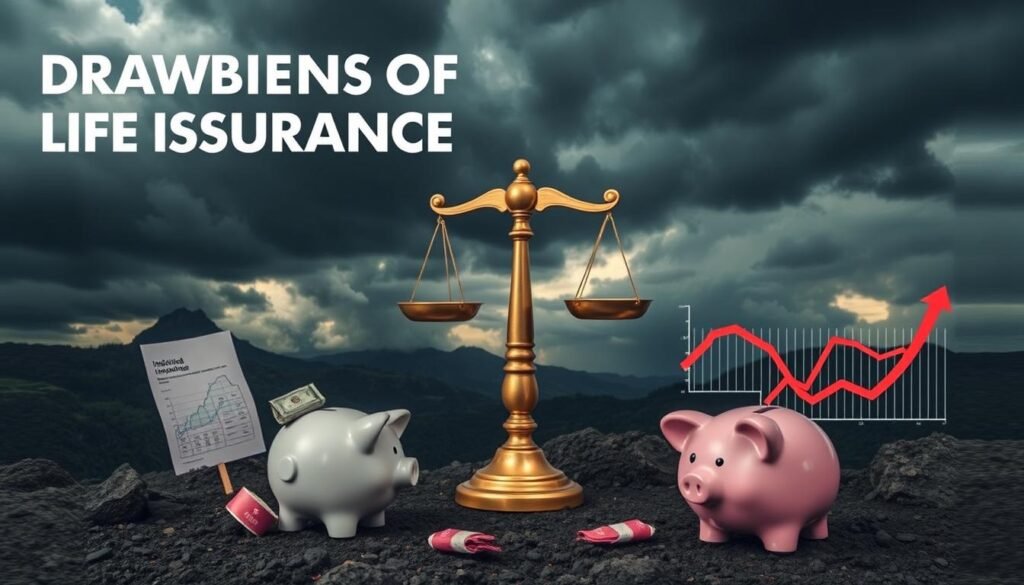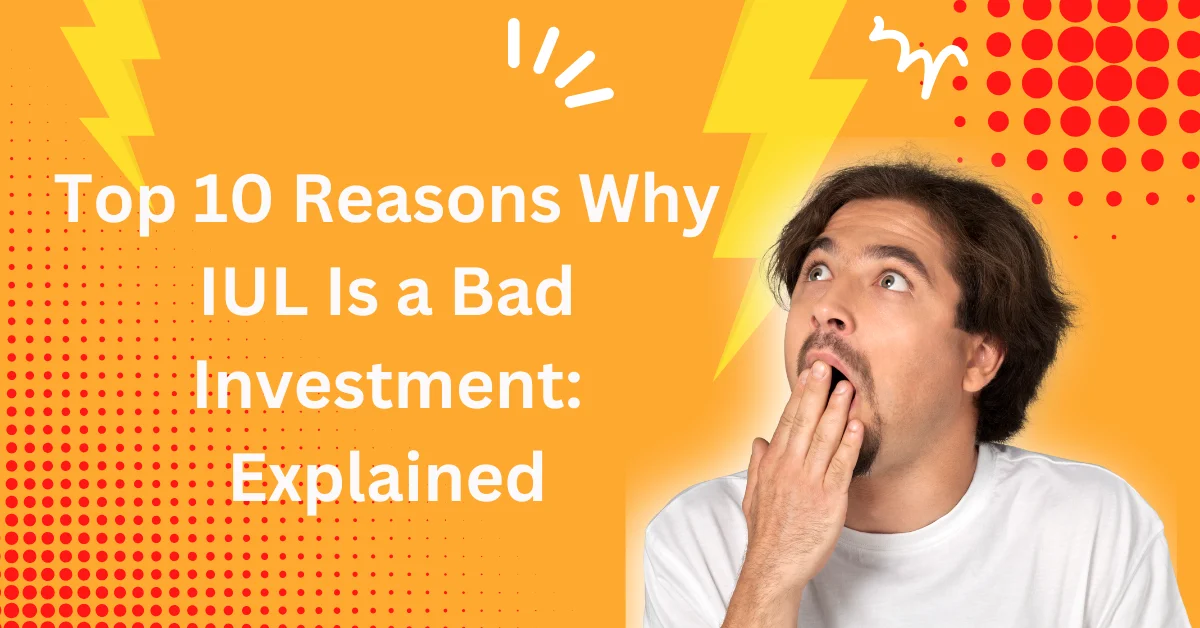Have you thought about if indexed universal life (IUL) insurance might harm your financial goals? I’ve explored the world of financial products and think it’s key to talk about why IUL is a bad investment. This article will dive into the downsides of 10 Reasons Why IUL Is a Bad Investment, showing why these policies can confuse and not protect your money. I want to improve your financial knowledge and help you choose wisely for your investments.

Let’s look at the main reasons why IUL insurance isn’t as good as it seems. We’ll cover fees, performance issues, and risks in retirement planning. Knowing these points is crucial for judging IUL and making sure your investments grow over time.
Key Takeaways
- Understanding IUL complexities is vital for sound financial planning.
- High fees associated with IUL can erode potential returns.
- IUL products often exhibit poor cash value growth.
- Market fluctuations can significantly impact returns on IUL investments.
- There are better alternatives available for enhancing financial security.
Understanding Indexed Universal Life (IUL) Insurance
Indexed Universal Life (IUL) insurance is a mix of life insurance and investment. It has a death benefit for loved ones and a cash value that grows over time. This growth is tied to a specific stock market index. Many see IUL as a way to get high returns while still having life insurance.
How IUL insurance works is interesting. A part of my premium pays for life insurance, and another for admin costs. The rest goes into the cash value account. This account can grow based on the index’s performance. This makes people wonder, is IUL a good investment?
The tax-deferred growth of IUL policies is a big plus. It means the cash value grows without being taxed right away. This is a strong reason to look into IUL. Plus, IUL policies let me pay premiums in flexible ways. This makes them appealing for those looking for a flexible investment strategy.
10 Reasons Why IUL Is a Bad Investment
Indexed Universal Life (IUL) insurance has gained popularity lately. However, I see several concerns about its investment value. Knowing these reasons can help you make better choices.
High Fees and Charges of IUL Products
IUL fees and charges are a big issue for me. High administrative fees, insurance costs, and surrender charges can eat into your profits. These fees can differ a lot between policies, making it hard to compare them.
This complexity can lead to unexpected costs. These costs can hurt your investment’s overall performance.
Complexity and Lack of Transparency
IULs seem appealing because of their flexibility and growth potential. But, their complex contracts confuse many. Terms like caps on growth and participation rates add to the confusion.
This lack of clarity makes it hard to know the true value of your investment. It’s important for investors to understand the implications of their choices in these complex situations.

Performance Issues of Indexed Universal Life
Policyholders should know about several factors affecting IUL returns. These can greatly impact financial planning. Understanding cap rates and stock market performance is key to seeing IUL’s limitations.
Cap Rates and Their Impact on Returns
Cap rates are crucial in limiting IUL growth. They set the maximum yield in good market times. Even in strong stock market years, cap rates can still cap IUL earnings. This often leads to lower returns than other investments.
Here’s a brief comparison of average cap rates versus the potential returns of a bolstered stock market:
| Market Scenario | Potential Stock Market Return | Typical IUL Cap Rate |
|---|---|---|
| Strong Bull Market (e.g., 15% Annual Growth) | 15% | 8% |
| Moderate Growth (e.g., 10% Annual Growth) | 10% | 6% |
| Market Decline (e.g., -5% Annual Growth) | -5% | 0% |
Stock Market Dependence and Risks
IUL returns heavily rely on the stock market. This makes them vulnerable to market volatility. During economic downturns, IUL returns can reflect these ups and downs. This often results in disappointing cash value growth for policyholders.
Those looking for stable investments might find IULs don’t meet their long-term goals.
Drawbacks of IUL in Retirement Planning
When I look at retirement planning, I must consider the downsides of IUL. These policies can make my financial situation more complex. They also bring long-term risks that might not be clear at first. I want to explore the investment risks and how hard it can be to get to my money.
Long-Term Investment Risks
The risks of IUL policies include lower cash values if investments don’t do well. If I miss premium payments, my policy could shrink, hurting my retirement savings. This uncertainty worries me as I get closer to retirement, when I need financial stability.
Changes in interest rates and market trends can also hurt the growth of my cash value. This means I might end up with less than I expected.
Withdrawal Restrictions That Limit Access
IULs have rules that make it hard to get to my cash value in retirement. Even though they promise to grow my funds, I might face penalties or fees when I try to withdraw. This can be stressful, especially when I need money most.
It’s key to think about how these rules affect my retirement plan. Do they match my financial goals? Or do they create more problems than solutions?

Cons of Indexed Universal Life Insurance
Indexed universal life insurance has its downsides, mainly its potential for slow cash value growth. Many people find that IULs don’t live up to their promise of matching market index performance. This can be a big issue for those hoping for steady financial growth.
Potential for Poor Cash Value Growth
The cash value growth in IULs can be quite different. The use of market indices doesn’t always lead to big returns. Growth caps can also limit how much you can build up. This can be a big letdown for those expecting high growth.
Comparison with Whole Life Insurance
Looking at IUL vs. whole life insurance shows clear differences. Whole life insurance offers guaranteed cash value growth, making it more reliable. This stability is a big plus compared to the ups and downs of IULs. For those wanting sure and steady growth, whole life insurance might be better.
IUL Investment Risks to Consider
Investing in Indexed Universal Life (IUL) insurance comes with risks. It’s important to understand how market volatility and interest rate changes can affect your investment. These factors can impact the growth and benefits of your IUL policy.
Market Volatility and Its Effects
Market volatility is a big risk for IUL investments. The cash value of these policies often depends on the stock market’s performance. When the market is unpredictable, returns can be hard to predict.
In some cases, you might even lose money. During big market drops, the cash value can decrease. This makes investors wonder if their investment is working.
It’s key to see how these ups and downs can hurt your long-term financial plans.
Interest Rate Fluctuations
Interest rate changes are another big challenge. The returns on IULs are tied to assets like indexes and bonds. When interest rates go down, the caps on returns can also drop.
This means you might not get the benefits you expected. It’s crucial to understand how rate changes can affect your returns. This knowledge helps you make better investment choices.

| Type of Risk | Impact on IUL | Considerations |
|---|---|---|
| Market Volatility | Unpredictable cash value growth | Ability to withstand market swings |
| Interest Rate Fluctuations | Reduced cap on returns | Monitoring interest rate trends |
Understanding IUL Limitations
Indexed Universal Life (IUL) insurance might seem good at first. But, it’s key to know its limits before getting it. These policies can cause confusion about how they work and what they offer.
One big issue is how insurers define the market. The rules for how they calculate performance can be tricky. For example, cap rates look promising but can really limit how much your money grows.
Also, getting your money out can be hard. The rules on withdrawals can make it seem like you have more freedom than you do. This can make it tough to use your money when you need it.
To show these problems, let’s look at a comparison:
| Aspect | Expectation | Reality |
|---|---|---|
| Cap Rate | 12% | 8% |
| Withdrawal Flexibility | High access to cash value | Limited access after initial years |
| Growth Potential | Supportive of long-term wealth | Constrained by market conditions |
IULs have many fees, rules, and promises that can lead to wrong ideas about them. Knowing what you’re getting into is crucial. This way, you can make smart choices for your money’s future.

Common Criticism and Controversies Surrounding IUL
The indexed universal life insurance (IUL) world has faced a lot of criticism and controversy. Many people are worried about the complex nature and marketing tactics of these products. Knowing about these issues can help people make better choices for their financial future.
IUL Products in the Financial Industry
Recently, many consumer groups have spoken out against IUL practices. They say insurers sometimes give false information about what these products can offer. This lack of clear information leads to complaints, especially when people find out their investments aren’t doing well. It’s important to understand these products well to avoid being misled.
Consumer Complaints and Concerns
Many people have complained about how IUL policies are sold. They say agents often hide the fees and limits, making it seem like a safer investment than it is. It’s crucial to raise awareness about these issues to help people make better financial choices. Knowing both the good and bad sides can protect against bad marketing.
| Concerns | Description |
|---|---|
| Misleading Returns | Misrepresentation of potential returns from IUL products. |
| High Fees | Policyholders often discover unexpected fees that diminish their cash value. |
| Lack of Transparency | Insufficient information from agents about how IUL products function. |
| Limited Access | Withdrawal limitations can hinder access to cash value when needed. |
Alternatives to IUL Investments
Reflecting on Indexed Universal Life (IUL) insurance, I see the need to look at other investment options. There are many alternatives to IUL investments. These options can help find a financial plan that fits your goals.
From different insurance products to various investment vehicles, there are many choices. These choices might offer better growth and lower risk.
Exploring Other Insurance Products
Looking at other insurance products, whole life and term life insurance are good alternatives. Whole life insurance gives a guaranteed death benefit and cash value that grows. But, it might have higher premiums.
On the other hand, term life insurance offers death benefits without cash accumulation. It usually costs less. Both can meet important financial needs, offering clarity and simplicity that IULs sometimes lack.
Investment Strategies Beyond IUL
Investment strategies beyond IUL, like index funds and traditional retirement accounts, are also worth looking at. Index funds track a specific index and often have lower fees. Traditional retirement accounts, such as a 401(k) or IRA, help with long-term growth and offer tax benefits.
Exploring these alternatives helps me build a diversified investment portfolio. This portfolio meets my financial goals without the drawbacks of IULs.
Here’s a simple and SEO-friendly conclusion for your article “Top 10 Reasons Why IUL Is a Bad Investment: Explained” aimed at a 6th to 8th-grade audience in the USA:
Conclusion
In the end, Indexed Universal Life (IUL) Insurance may sound like a good deal, but it comes with a lot of hidden costs and risks. While it promises flexible premiums and a cash value, the truth is that many people don’t get the returns they expect. Instead, they end up paying more in fees, facing investment risks, and getting less coverage than they thought.
If you’re thinking about long-term savings, there are other options like term life insurance or even investing in simple, low-cost savings accounts. It’s important to understand that not all life insurance plans are the same, and IUL policies often don’t live up to the hype. Before you make a decision, talk to a financial advisor and weigh your options carefully.
FAQ
What is indexed universal life (IUL) insurance?
Indexed universal life insurance (IUL) is a type of permanent life insurance. It combines a death benefit with a cash value component. This cash value can grow based on a stock market index’s performance.
It offers flexibility in premiums and potential for cash value growth linked to market indices. But, it also comes with complexities and risks.
Is IUL a good investment?
Many financial experts say IULs are not a good investment. They point out high fees, complexity, and limited growth potential. It’s key to understand the drawbacks of IUL, including potential performance pitfalls and market volatility’s impact.
Can I lose money in an IUL?
While the cash value in an IUL has some protections, returns can be modest. This is due to cap rates and market dependence. If the market doesn’t perform well or fees are high, you might see little to no growth. This can feel like a loss.
What are the main drawbacks of IULs?
Some main drawbacks of IULs include high fees and administrative costs. They are also complex and lack transparency. There’s a potential for poor cash value growth, withdrawal restrictions, and reliance on stock market performance.
Understanding these limitations is critical for effective financial planning.
How do I compare IUL to whole life insurance?
When comparing IUL to whole life insurance, note that whole life offers guaranteed cash value growth. It also has fixed premiums. IULs, on the other hand, have variable cash value growth linked to market indices. They may have adjustable premiums but carry greater risks.
What investment strategies are better than IUL?
Alternatives to IUL include traditional retirement accounts like 401(k)s and IRAs. Index funds and straightforward whole or term life insurance products are also good options. These often provide more predictable returns and lower fees compared to IULs.
What is the catch with an IUL?
The catch with an IUL often lies in its complexity, hidden fees, and caps on growth potential. While it may seem attractive due to its hybrid nature, the intricacies and potential costs can lead to disappointing performance over time. This is especially true during bullish market periods.
Are there consumer complaints about IULs?
Yes, there are many documented consumer complaints regarding IULs. Issues often stem from misleading marketing practices. There’s also a lack of clear information regarding fees, potential growth, and the risks associated with the product.
What are the long-term risks of IUL policies?
Long-term risks of IUL policies include stagnated cash value growth. There’s also the possibility of higher-than-expected fees affecting returns. Additionally, there are restrictions on withdrawals or access to funds during retirement. This can lead to financial strain when liquidity is essential.
How do cap rates impact IUL investments?
Cap rates limit the maximum amount of cash value growth an IUL can achieve during favorable market conditions. This means that while your investment may be linked to an index, the actual returns can be significantly lower. This impacts your overall financial goals.

